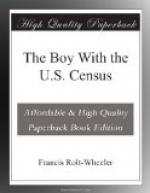The keyboard was entirely strange to Hamilton. It looked not unlike that of a big typewriter, or resembled even more closely a linotype keyboard, only it was divided off into sections each one of which was brightly colored, giving the arrangement of the keys quite a gay effect. The instructions were very clear, and with the machine in front of him the boy quickly saw its principles. He was so deeply sunk in the book that he did not notice the coming of the sub-section foreman, who looked down at the boy for a moment or two with an amused smile. Presently he coughed, and Hamilton looked up suddenly to see him standing there.
“I beg your pardon,” asked the boy, “were you speaking?”
“No,” said the newcomer, “but I was going to before long. You seem to be just eating up that book.”
“Mr. Cullern said he thought you would be here before very long,” said Hamilton, rightly guessing that this must be the foreman, “and I thought the more I knew about it before you came, the better it would be all ’round.”
“Do you know anything about census work?” was the next question.
“Yes, sir,” the boy answered, “I was an assistant special agent on the manufactures division, and I only left my population district the day before yesterday.”
“I thought it likely that you had been doing enumeration work,” the foreman answered, “coming in to-day, just when that end of the work closes, but I didn’t know, of course, you had been doing manufactures. I wonder why they sent you to this department; I should have supposed that you would be editing schedules.”
“I hope to go on the Census Bureau force permanently,” the boy explained, “and I was anxious to have a chance to learn all the various parts of the work by doing them myself. Judging from this book, it doesn’t seem hard.”
“Let me hear what you know about it.”
Hamilton closed the book.
“I think I have it fairly straight,” he said. “These first four columns on the card I have nothing to do with, so far as I can make out; is that right?”
“Yes,” the older man replied, “that is looked after in another way. The district and State and all that sort of thing go in that section, and that is arranged by what we call a gang-punch.”
“I don’t know how that works,” the boy said, “this list of instructions to the punching clerk doesn’t say anything about it.”
“It doesn’t need to,” his informant answered, “for the simple reason that the punching clerk has nothing to do with it. But I’ll tell you if you want to know. There are about seventy thousand enumeration districts in the United States, and all we have to do is to set the gang-punch to the number of the district.”
“But there are not seventy thousand divisions on the card or anything like it,” the boy cried, “all told there are only forty-eight places in those four columns.”




